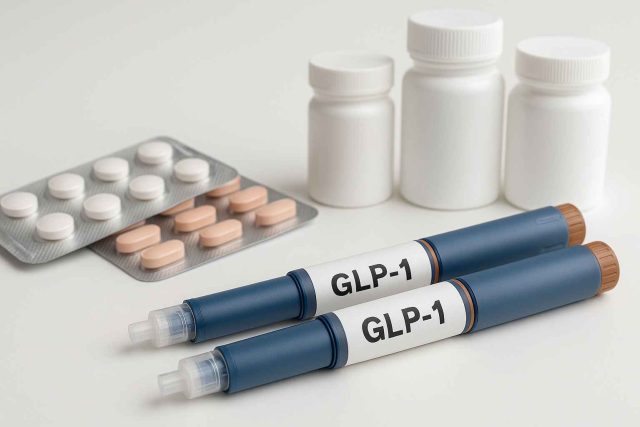
Table of Contents
- Introduction
- Expanded Indications for GLP-1 Receptor Agonists
- Emerging Therapies and Oral GLP-1 Options
- Cardiovascular and Renal Benefits
- Safety Considerations and Adverse Effects
- Conclusion
- FAQs
Introduction
Imagine a single class of medication that not only manages blood glucose but also offers cardiovascular and renal protection, aids in weight loss, and potentially reduces cancer risk. The 2025 GLP-1 guidelines have positioned these drugs at the forefront of type 2 diabetes management, reflecting their multifaceted benefits. As the landscape of diabetes therapies evolves, understanding these updates is crucial for clinicians aiming to provide comprehensive care.
Expanded Indications for GLP-1 Receptor Agonists
The 2025 American Diabetes Association (ADA) Standards of Care have broadened the use of GLP-1 receptor agonists beyond glycemic control. These medications are now recommended for patients with type 2 diabetes and chronic kidney disease to reduce cardiovascular risk and protect renal function. Additionally, for individuals with type 2 diabetes, obesity, and heart failure with preserved ejection fraction, GLP-1 receptor agonists are advised to manage glucose and alleviate heart failure symptoms. Moreover, for adults with type 2 diabetes or prediabetes and nonalcoholic fatty liver disease (NAFLD), the ADA suggests considering GLP-1 receptor agonists or dual GIP/GLP-1 receptor agonists as part of the treatment plan. NIDDK
Emerging Therapies and Oral GLP-1 Options
Eli Lilly’s development of orforglipron, an oral GLP-1 receptor agonist, marks a significant advancement in diabetes treatment. In a Phase 3 trial, orforglipron demonstrated a reduction in HbA1c levels by up to 1.6% and an average weight loss of 16 pounds over 40 weeks. This oral formulation offers a convenient alternative to injectable therapies, potentially improving patient adherence. Novo Nordisk is also exploring innovative treatments, such as CagriSema, a combination of semaglutide and cagrilintide. In the REDEFINE 2 trial, CagriSema achieved a 15.7% weight loss in patients with type 2 diabetes over 68 weeks. These developments underscore the expanding arsenal of diabetes drugs available to clinicians.
Cardiovascular and Renal Benefits
Beyond glycemic control, GLP-1 receptor agonists have demonstrated significant cardiovascular and renal benefits. The FDA approved Ozempic (semaglutide) to reduce the risk of major adverse cardiovascular events in adults with type 2 diabetes and established cardiovascular disease. Additionally, these agents have been shown to slow the progression of diabetic kidney disease, offering a dual benefit for patients at risk. Furthermore, emerging evidence suggests that GLP-1 receptor agonists may lower the risk of obesity-related cancers. A study presented at a major cancer research conference indicated a slightly reduced incidence of such cancers among adults with diabetes taking GLP-1 medications compared to those on other diabetes drugs.
Safety Considerations and Adverse Effects
While GLP-1 receptor agonists offer numerous benefits, clinicians should be mindful of potential adverse effects. Common side effects include gastrointestinal symptoms such as nausea, vomiting, and diarrhea. Rare but serious risks involve pancreatitis and gallbladder disease. Recent studies have also explored the ocular risks associated with GLP-1 therapies. Some findings suggest a potential link between these medications and diabetic retinopathy progression, particularly in patients with pre-existing eye conditions. Therefore, regular ophthalmologic evaluations are recommended for patients initiating GLP-1 therapy. Endocrinology Advisor
Conclusion
The 2025 GLP-1 guidelines reflect a paradigm shift in the management of type 2 diabetes, emphasizing the multifaceted benefits of these agents. As diabetes drugs continue to evolve, clinicians must stay informed about emerging therapies, expanded indications, and safety considerations to optimize patient outcomes. For more in-depth analyses and the latest updates on diabetes management, visit our Insights section.
FAQs
- What are GLP-1 receptor agonists? GLP-1 receptor agonists are a class of medications that mimic the glucagon-like peptide-1 hormone, enhancing insulin secretion, suppressing glucagon release, and slowing gastric emptying to lower blood glucose levels.
- Who should consider GLP-1 therapy? Patients with type 2 diabetes, especially those with cardiovascular disease, chronic kidney disease, obesity, or NAFLD, may benefit from GLP-1 receptor agonists as part of their treatment regimen. NIDDK 😊
- Are there oral GLP-1 options available? Yes, orforglipron is an oral GLP-1 receptor agonist currently under development, showing promising results in clinical trials for glycemic control and weight loss.
- What are the common side effects of GLP-1 therapies? Common side effects include nausea, vomiting, diarrhea, and potential risks of pancreatitis and gallbladder disease. Ocular complications have also been reported in some cases.
- Where can I find more information on diabetes management? For comprehensive resources and the latest research, visit Diabetes in Control.
This content is not medical advice. For any health issues, always consult a healthcare professional. In an emergency, call 911 or your local emergency services.